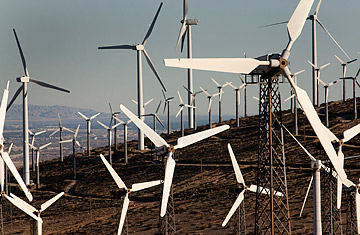
It's been a schizophrenic time for the U.S. solar industry. On the one hand, about $11 billion worth of solar power is set to be installed in 2012, with more than five times that figure in the investment pipeline. Demand for solar power rose eightfold between 2006 and 2011 — from 200 MW to 1,600 MW. Nationally, the solar industry employs some 100,000 Americans, a number that rose by nearly 7% last year — even as overall employment barely grew at all.
Despite those rosy numbers, many U.S. solar companies — especially those that manufacture solar panels and modules — are struggling to survive. Most notably, the solar start-up Solyndra went under in 2011, taking with it over $500 million in government loan guarantees. The Bloomberg Large Solar Energy Index of 17 top solar companies lost more than two-thirds of its value in 2011.
In other words, if you're buying solar panels or running a business installing them, life is good, but if you own a company that actually makes solar equipment in the U.S., you're looking at a lot of red ink. That's because solar power is getting much cheaper — prices for modules have dropped 40% over the past five years. According to some U.S. solar-panel manufacturers, that drop in price is due largely to low-cost imports from Chinese panelmakers. It's not that their manufacturing methods are necessarily better than ours. It's that government support from Beijing and low-cost labor make it easy for China to undercut its U.S. competitors. The result is more and cheaper solar power for Americans — but perhaps less market share for U.S. manufacturers.
Those concerns prompted the U.S. arm of the German manufacturer SolarWorld AG to file a complaint on behalf of companies that say they're being harmed by unfair Chinese trade policies. The U.S. Department of Commerce has been investigating the complaint and is scheduled to make a decision by March 2 (though the announcement has already been delayed twice). If investigators conclude that Beijing has been unfairly aiding its solar exporters, the government could slap hefty tariffs on imported Chinese panels — as much as 50% to 100% of the modules' value.
It's not yet clear where the U.S. government will come down on the complaint, though it's notable that President Obama announced during last week's State of the Union address that he would create a new Trade Enforcement Unit to speed investigations of unfair trading practices. He specifically mentioned China as a target, noting that his Administration has brought trade cases against Beijing at nearly twice the rate of his predecessor. "I will not stand by when our competitors don't play by the rules," Obama said.
That kind of aggressive posture may be needed, because U.S. solar manufacturers and their workers are indeed getting their butts kicked by China, which already accounts for three-fifths of the world's solar-panel production, most of which is exported to the U.S. and Europe. But while tariffs could help domestic panelmakers — not to mention appealing to an America-first impulse that is especially acute as the economy struggles — the move would raise the overall price for solar power in the U.S.
That, in turn, would hurt consumers who want solar power as well as the U.S. companies that install and maintain the modules. In fact, there's a bit of a civil conflict brewing within the U.S. solar industry over the impending trade war. Many renewable-energy advocates argue that tariffs could backfire, stopping the growth of solar installation in the U.S. just as it's set to really take off, not to mention harming the environment and destroying American jobs.
That's the conclusion of a study commissioned by the Coalition for Affordable Solar Energy (CASE) — which opposes the tariffs — and put together by consultants at the Brattle Group. The analysis found that a 100% tariff on imported modules would result in a net loss of as many as 50,000 jobs in the U.S. over the next three years and would cost consumers between $700 million and $2.6 billion. A 50% tariff would eliminate up to 43,000 jobs and cost consumers from $600 million to $2.3 billion. "The analysis makes it clear that tariffs on polysilicon solar cells would be devastating for American workers," says Jigar Shah, the president of CASE and a renewable-energy veteran. "We can't allow one company's anti-China crusade to threaten the U.S. solar industry and tens of thousands of jobs."
As the range of the forecasts indicates, it's difficult to predict just how major tariffs would affect the U.S. solar industry, and in a statement, a coalition of U.S. solar manufacturers called the study "highly speculative." But we know the impact of tariffs wouldn't be pretty — and you can bet that China, which has already launched its own investigation into U.S. renewable-energy policy, would take measures against U.S. solar exports. "These are not trivial numbers," says Mark Berkman, the author of the report and a principal at Brattle.
Here's the unfortunate truth: for all the talk about renewable energy recharging U.S. manufacturing, the cheapest solar panels will probably be made in China. (Solar panels are quickly becoming a commodity, and China tends to dominate commodity manufacturing.) If solar is going to become more than a rounding error in the global energy budget, it needs to get extremely cheap — but that may leave U.S. factory workers out of luck, although there are plenty of good domestic jobs available in installing and maintaining panels. Solar may still be the energy source of the future — but it might not be made in the USA.
